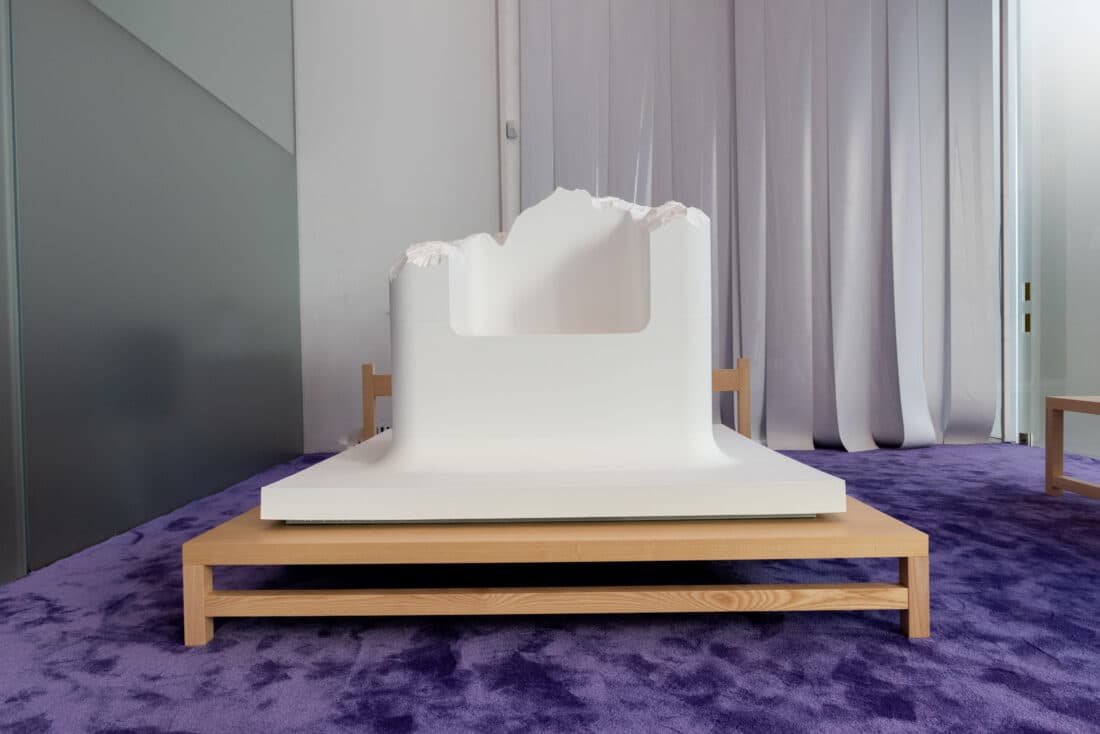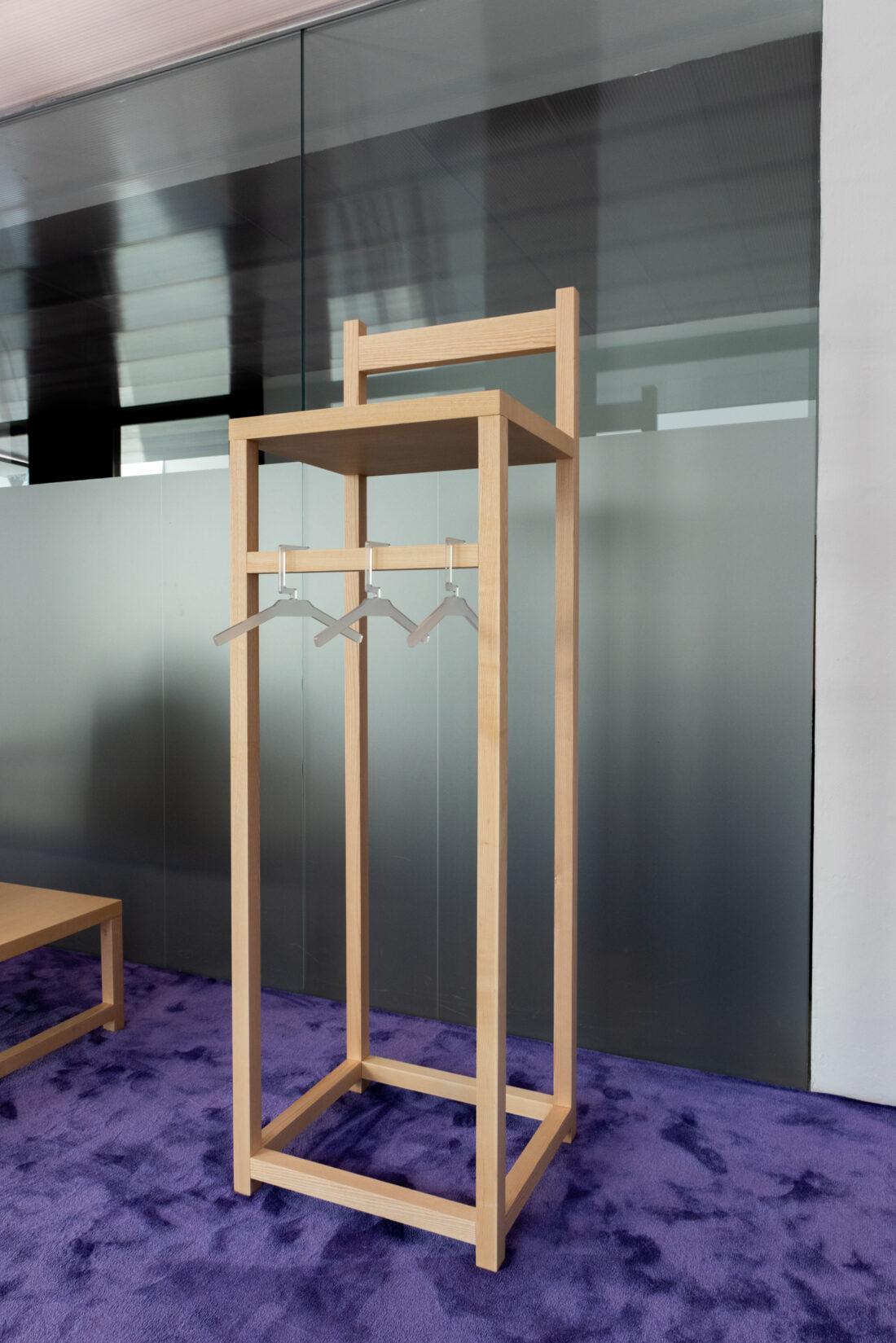PlayLab, Inc has different ideas about what’s normal. The Los Angeles-based multi-disciplinary studio has spent the last few years working closely with brands like Louis Vuitton, Off-White, Reese Cooper, and more, delivering reality-altering set designs. For Milan Design Week, PlayLab has created a chair that challenges traditional ideas about what a chair is and how an exhibition should function.
We spoke with the PlayLab team, including Art Director Dillon Kogle, about the studio’s contribution to Daniel Arsham’s Art & Residence program and he described the significance of how chairs fit in our culture. “The chair, out of domestic fixtures, has definitely become the hero of them,” says Kogle. “Chairs really do seem to have really captured audiences forever.” The way he tells it, the universality of the chair would ultimately become PlayLab’s window into something more for this exhibition. “ [Chairs] are pretty boundless. We’ve made them mean so many different things, whether it is about sentiment, whether it is about utility or utility becoming sentiment.”
The design of PlayLab’s own chair plays a significant part in the overall presentation of Daniel Arsham’s Art & Residence Program in Milan this year. The residency puts Arsham’s expertise as a curator on display, this time delivering the creative interpretation of chairs through the lens of nine different designs at Milan Design Week. For PlayLab, though, the task at hand for this event was not just to create a piece to be put on display, but to design the presentation and exhibition space and how to blend these demands together.

Hidden’s Milan Design Week Piece displayed on PlayLab, Inc’s One Chair
Tasked with both the creation of their own chair to be put on display and the space itself, PlayLab dug deep into the “boundless” nature of the chair in search of a singular solution to both design challenges. “We are the studio that is tasked with the exhibition design, as well as contributing a chair to the show. I really wanted our solution to do both of those things simultaneously,” Kogle says before detailing the thought process that would eventually lead to the creation of the One Chair. “There were a couple of different ways that we went about solving that,” he says. “And we’ve landed on one, even though it’s such an almost comically simple solve for this thing, like display chairs on chairs.” You read that right: PlayLab’s design had to act as platforms on which all the other chairs in the exhibit would be displayed. So not only were they making a chair, they had to make a chair that any other chair could sit on while not pulling the focus from the other chairs. A tall task.
The One Chair is the result of PlayLab’s ironic solution to their Milan Design Week challenge. In its most basic form, the One Chair is a relatively minimal and simple piece with its roots in Shaker design, but at the exhibition in Milan the One Chair is almost everything except a chair. In order to make certain that the One Chair could serve as the display platform for every other chair in the exhibition, PlayLab made their piece radically customizable. This flexibility allows for the chair’s dimensions to morph and mutate, stretching and elongating, growing taller or becoming shorter in order to serve the piece it is displaying.

Snarkitecture’s Milan Design Week Piece displayed on PlayLab, Inc’s One Chair
When speaking to the flexible nature of the One Chair, particularly its role as a fixture for displaying the other pieces in the exhibition, Kogle said, “the more common understanding of this thing is that it’s a bunch of chairs to put other chairs on.” But he also alludes to the nuance of creating something so universal that it can be used for more than its intended function. “A lot of thought first went into what is its behavior,” he says. “What is the choreography, if you will, of what this chair has to do to become all these different mutants of itself?”
As the PlayLab piece mutated, it still needed to maintain its singular identity even as it took on an infinite amount of different shapes, sizes, and use cases. “We decided that the idea was that there was a chair design that was going to perform any of the needs of the build out,” Kogle said. The culmination of this idea led to a full exhibition at Milan Design Week of curated chairs being displayed on the One Chair in all different shapes and sizes. “The reverence of having a chair show at Salone should be about celebrating chairs. And so, again, almost in a nuanced clever way, but much more so in a flat comical way, chairs really became the question and the answer.”

Daniel Arsham x USM’s Milan Design Week Piece displayed on PlayLab, Inc’s One Chair
Through this complex maze of questions and answers, one question rises to the top: “What is it?” This ends up becoming a window to give us a look at the studio’s design process. “These things almost naturally come out as what they want to be,” Kogle sais. “It’s like our hands are on them, it’s almost like the chair in that form existed and we were finding it, which can sound so corny, but it is something like that.”
Sometimes, affirmative questions don’t get to the heart of the matter. Sometimes you have to ask the question the other way, “What isn’t this chair?”. To this, Kogel described the “sentiments and precedences and notions and small decisions and functions” of the chair, saying, “it is all of those things summed up into an object.” Of course, he quickly added cheekily, “What is the [One] Chair not? A chair.” And in a sense, it isn’t purely a chair, at least as far as its function is concerned, it’s more of a pedestal, more of a fixture.
The One Chair is relatively boundless and mutating nature makes it an excellent pedestal for this Milan Design Week exhibition. Minimalist in its appearance, the One Chair can maintain its own relatively abstract and playful identity without taking anything away from the pieces displayed on it. Displayed on its own, however, the One Chair’s flexibility gives it the opportunity to function within seating’s traditional bounds, or become something else altogether.

PlayLab’s One Chair
For the studio’s official contribution to the Milan Design Week exhibition, PlayLab’s One Chair mutates in a way that shows off the uninhibited nature of the piece. While the versions of the One Chair used to display the other pieces at the exhibition were mostly stretched and elongated, the version shown by the studio as a part of the event was made taller and more narrow than others seen in the space. Their exhibition version of the One Chair is tall enough that the studio has put clothes hangers on it, which gives new meaning to something Kogle said during our interview, “The design critique and reasoning goes out the window when you’re just like, can I throw my dirty laundry on this chair and feel okay.” By the looks of it, the One Chair is as fitting for clean laundry as it is for dirty, because it’s become a closet. Somehow it’s no longer even a chair anymore, but still looks like a chair if you’re tall enough to sit on it. It has mutated again, but still within the boundaries of everything their design has permitted.
PlayLab’s work is on display during Milan Design Week along with the other creatives involved in the Art & Residence Program presented by Daniel Arsham and StockX. “Art & Residence” presented by Daniel Arsham & StockX explores this converging of worlds and taps non-traditional creatives to push the boundaries of what a chair can be. From fashion designers to architects, “Art & Residence” bridges creative communities – from the world of StockX, to the storied platform of Milan Design Week. For more information on the creatives involved in the program, you can click here.



